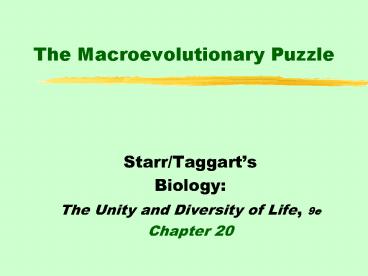The Macroevolutionary Puzzle - PowerPoint PPT Presentation
1 / 19
Title:
The Macroevolutionary Puzzle
Description:
The Macroevolutionary Puzzle Starr/Taggart s Biology: The Unity and Diversity of Life, 9e Chapter 20 Key Concepts: All species that have ever lived are related ... – PowerPoint PPT presentation
Number of Views:92
Avg rating:3.0/5.0
Title: The Macroevolutionary Puzzle
1
The Macroevolutionary Puzzle
- Starr/Taggarts
- Biology
- The Unity and Diversity of Life, 9e
- Chapter 20
2
Key Concepts
- All species that have ever lived are related
- Macroevolution refers to patterns, trends, and
rates of change among lineages over geologic time - Fossil and geologic records and radiometric
dating of rocks provide evidence of macroevolution
3
Key Concepts
- Anatomical comparisons help reconstruct patterns
of change through time - Biochemical comparisons also provide evidence of
macroevolution - Diversity characterizes the distribution of
species through time - Taxonomy is concerned with identifying and naming
new species
4
Fossils Evidence of Ancient Life
- Fossilization is slow process
- Stratification
- Layering of sedimentary deposits
- The older the layer, the older the fossils
- Geologic Time Scale
- Based on sequences of fossils in sedimentary
rocks
5
Comparative Morphology
- Comparison of body forms and structures
- Morphological divergence
- Change from body form of a common ancestor
- Morphological convergence
- Body parts in remote lineages become similar
under similar selection pressures
6
Comparative Morphology
- Homology
- Similarity in body parts in different organisms
- Attributable to descent from a common ancestor
- Analogy
- Similarity in body parts in different organisms
- Attributable to similar environmental pressures
7
Homologous Structures
- Vertebrate forelimbs
8
Comparative Embryology
- Early vertebrate embryos strongly resemble one
another - Same plan of development
9
Changes in timing of developmental steps
- Skull bones of chimpanzee and human
- Changes in growth rate timing of developmental
steps
10
Evidence from Comparative Biochemistry
- Molecular clocks
- Neutral mutations
- Protein comparisons
- Cytochrome C
- Nucleic Acid comparisons
- Base-pairing of DNA or RNA from one species to
another
11
Identifying SpeciesPast and Present
- Taxonomy
- Assigning species names
- Binomial system
- Genus and Species
- Higher Taxa
- Family, Order, Class, Phylum, and Kingdom
12
Finding Evolutionary Relationships Among Species
- Classical systematics
- Cladisitics
13
How Many Kingdoms?
- Whittakers Five-Kingdom Scheme
- Monera
- Protista
- Fungi
- Plantae
- Animalia
14
Six Kingdom Scheme
- Carl Woese
- Includes the Archaebacteria
15
Three Domain Scheme
- Favored by microbiologists
- Eubacteria
- Archaebacteria
- Eukaryotes
16
A Changing Earth
- Plate tectonics
- Theory that plates of the Earths crust float on
the underlying mantle - Plates are in motion and have rafted continents
to new positions over time - Early supercontinents
- Gondwana
- Pangea
17
Radiometric Dating
- Half-life
- Time it takes for one half of a given quantity
of a radioisotope to decay into a daughter isotope
18
In Conclusion
- Macroevolution is the study of patterns, trends,
or rates of change among groups of species over
long periods of time - There is extensive evidence of evolution based on
similarities and differences in body form,
function, behavior, and biochemistry - Completeness of fossil records are variable
- Fossil and geologic record show that such changes
have influenced evolution
19
In Conclusion
- Comparative morphology reveals similarities in
embryonic development and identified homologous
structures - Comparative biochemistry has identified
similarities and differences among species - Taxonomists identify, name, and classify species
- developed by M. Roig






























